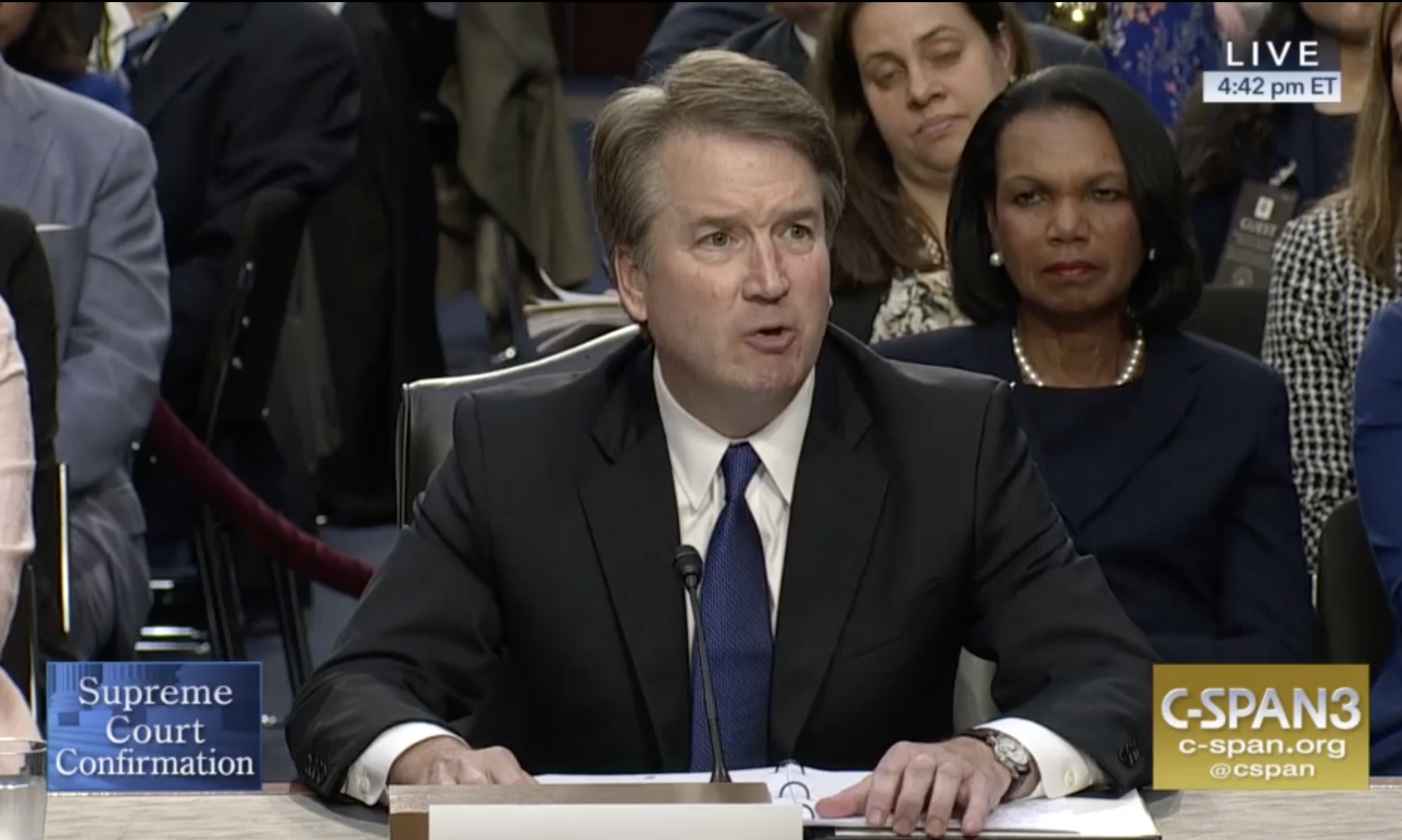By Bill Britt
Alabama Political Reporter
WASHINGTON, D.C.—Today, State Senator Cam Ward will testify before the U.S. House Judiciary Committee’s Subcommittee on Crime, Terrorism, Homeland Security and Investigation. Ward, will appear before before the body to give testimony concerning prison reform. Ward has been Alabama’s leading proponent of a smart, conservative reform in the face of the mounting dilemma facing the state’s prison system.
Alabama Political Report has obtained a copy of Ward’s prepared statement which may be read below.
Opening Statement Regarding Prison Reform in the States
Mr. Chairman, members of the committee thank you for giving me this opportunity to discuss the challenges that both the state and federal corrections systems in the United States face today.
I am in a unique position because I come from a state that faces the most serious challenges of any state in the union with regard to our Corrections system. This problem however, presents my state with some opportunities to address our challenges with meaningful reform that has already taken root in Alabama. The State of Alabama faces a great crisis in our Department of Corrections. At 192% capacity, we are the most overcrowded prison system in the country.
Despite this high incarceration rate, Alabama still has the 8th highest violent crime rate in the United States. This ranking, as well as the high incarceration rate, is evidence that our current model is not working. In light of the Plata decision regarding California’s Corrections system, it is estimated that in order for Alabama to achieve a Department of Corrections level of 137% capacity, we would need to spend an estimated $600,000,000 on prison construction. This amount of spending would be fiscally irresponsible and represent over one-half of our entire General Fund Budget. Spending your way out of this problem is out of the question.
In addition to construction costs, other ideas besides “spending your way out of this problem” must be considered. Alabama currently spends approximately $42.50 a day per inmate, ranking us the lowest in the country on spending. Bringing Alabama’s per-prisoner spending up to what Georgia or Florida spend per-prisoner would require a system-wide 20% increase in per-prisoner spending. Raising Alabama’s per-prisoner spending to what Arizona spends would require an over 40% increase in per-prisoner spending.
The prison overcrowding crisis has resulted in a bipartisan effort to address criminal justice issues to ultimately improve public safety, hold offenders accountable for their criminal conduct, reduce recidivism, and determine where the State’s limited resources can be best spent to accomplish these goals.
Alabama’s criminal justice crisis is complex and deeply rooted and there are no silver bullets to cure all that ails the system. Retired Alabama Circuit Court Judge Joseph A. Colquitt recently summarized it best when he said, “It is vital we do not succumb to oversimplifying a complicated process and accepting easy answers. In this complicated area of law, solutions that sound simple are invariably based upon limited information or faulty assumptions.”
While the situation appears bleak, the State of Alabama has been involved in dedicated reform efforts for well over a decade finding solutions to help improve the efficiency and effectiveness of the State’s criminal justice system, most recently in the creation of the Alabama Prison Reform Task Force. This Task Force, created by Act 2014-11, was the result of a letter submitted by Governor Robert Bentley, Chief Justice Roy Moore, House of Representatives Speaker Mike Hubbard, Alabama Senate President Pro Tempore Del Marsh, Alabama Department of Corrections Commissioner Kim Thomas and myself requesting the expertise of the Bureau of Justice Assistance, the Pew Charitable Trusts and the Council of State Governments. Alabama was subsequently selected as a site to participate in the Justice Reinvestment Initiative. In June of this year, Governor Bentley asked me to serve as the Chairman of this Task Force, which is comprised of 25 members from the public and private sector as well as all three branches of government. A special effort was made to include members from both political parties as well as inmate advocacy organizations and law enforcement.
22 states have previously participated in the Justice Reinvestment Initiative. Recently, South Carolina, North Carolina, and Mississippi have used this process to achieve reforms that should reduce their prison populations by 8-10%.
For decades, Alabama has grappled with a growing criminal justice system seemingly tugged in two different directions.
To moderate the spiraling prison population growth and in response to crisis conditions, Alabama has utilized various alternatives such as work release, pre-trial diversion programs, supervised intensive restitution, community corrections programs, correctional incentive time (good time), parole, special release dockets, drug courts, and new prison construction. While Alabama’s correctional history is replete with efforts to alleviate overcrowding, these efforts have always had to compete with laws and practices geared to punish offenders more severely, including the Habitual Felony Offender Act, sentence enhancements, good time restrictions, parole minimum time-served policies, and mandatory minimum sentences. The result of this balancing act is a complex set of laws, policies, and processes, each instituted over the past 30 years, to deal with the unique problem of the day. (Alabama Sentencing Commission 2003 Report).
The State began to recognize the severe challenges our system faced in 2000 when the Alabama Legislature created the Alabama Sentencing Commission to review Alabama’s existing sentencing structure, including all laws, policies, and practices. The Legislature further directed the Commission to provide recommendations on improvements to the State’s criminal justice system on an annual basis. The Commission is a 21-member body comprised of representatives from the three branches of state government and other major stakeholders in the state’s criminal justice system.
By the time the Commission was created, the entire criminal justice system was in need of comprehensive reform. Many believed the problems were too numerous and severe to resolve—an overcrowded prison system that had existed for years; county jails backlogged with state prisoners; a system lacking truth-in-sentencing; confusing prison release policies; insufficient community based sentencing options; and a general fund that had no money to spare.
The foundation for all recommendations and decisions made by the Commission has always been empirical evidence. The Commission established cooperative data sharing procedures with the Administrative Office of the Courts, Alabama Department of Corrections, Board of Pardons and Paroles, the Alabama Criminal Justice Information Center and the Alabama Community Corrections Association. These agreements allowed—for the first time in the state’s history—a comprehensive database to be created allowing for unprecedented insight into the state’s sentencing and correctional system. Applied Research Services (ARS), founded by Drs. Tammy Meredith and John Speir, was hired to help develop the Commission’s ability to collect, analyze, and interpret the immense amount of information.
Alabama recognized it could no longer afford to guess which policies would most effectively secure the safety of citizens but needed to join the ranks of states employing the use of empirically supported research to guide sentencing and criminal justice policy. In addition to not measuring what policies may or may not better protect public safety, the state did not have the ability to forecast or predict the impact of changes in sentencing laws and practices on criminal justice populations. ARS constructed, and the state still uses, one of the most accurate computerized correctional simulation models in the country. This tool allows the Commission to measure the impact of proposed laws or practices before implementation providing an essential tool for the development of an intelligent and carefully planned criminal justice system.
The major component of the Commission’s work has been the creation and recent modifications of the state’s Sentencing Standards (guidelines). One of the initial findings after reviewing years of statewide sentencing information was that sentencing practices varied immensely across the state. Even similarly situated offenders often received very different sentences (incarceration vs. community supervision and length of sentence). The Standards were developed to eliminate unwarranted sentencing disparity while maintaining meaningful judicial discretion. The initial Sentencing Standards that went into effect October 1, 2006 were voluntary. After reviewing years of information, the Initial Voluntary Sentencing Standards were not followed to the extent that was hoped. In the 2012 Regular Session, the Alabama Legislature directed the Commission to make the necessary modifications to the Initial Voluntary Sentencing Standards to transition to Presumptive sentencing for drug and select property offenses beginning October 1, 2013. This has not been without political debate within the law enforcement community. I have worked closely with our District Attorneys to make sure these guidelines do not hinder the prosecution or settlement of cases. As I have said before, this reform effort will continue to be a work in progress and further changes may be necessary to the sentencing guidelines.
Alabama can greatly reduce its’ overpopulation that depends solely on incarceration by using alternative sentencing programs. The problem is that Community Corrections programs that are currently in the state are not created by the state nor staffed by state employees. These programs can only be created by a county or non-profit agency pursuant to state law; however, they provide an essential service helping to alleviate state prison overcrowding by supervising felony offenders upon direction from courts and supervision of offenders leaving prison. Recognizing the state needed more community corrections programs and to make existing ones more efficient and effective, the Sentencing Commission recommended, and the Legislature later approved, the creation of a Division of Community Corrections within the ADOC with a full-time director and staff and an appropriation from the general fund budget earmarked for program implementation and operating costs. Out of the 67 counties in Alabama, there are 48 counties with a community corrections program and ADOC continues to coordinate with other counties to establish new programs.
Community Corrections Programs (CCP) offers a variety of services as alternative punishment options for judges to utilize to assist the state, counties and municipalities with crowding within incarceration facilities. The purpose of community corrections is to provide services that expand the options available for sentencing criminal defendants. By diverting low to medium-risk offenders from prison, scarce prison space is available for the incarceration of violent and repeat offenders. Many offenders exhibit characteristics that are static and cannot be changed. However, dynamic factors such as poor work habits, criminal associates and lack of educational training can be impacted through targeted interventions. Offenders who display a range of actions that are correlated with criminal conduct respond well to such interventions.
To improve community corrections outcomes, the Alabama Department of Corrections (ADOC) adopted evidenced based practices. In 2012, ADOC implemented a validated risk and needs assessment instrument known as the Alabama Risk Assessment System (ARAS) for community corrections offenders. The goal of the system is to provide assessment tools that are predictive of recidivism for offenders, which allow county programs to allocate critical resources to those offenders who have an increased risk of recidivating.
Additionally, ADOC developed and implemented a statewide Community Corrections Offender Contact/Supervision Matrix based on the principles in the Alabama Risk Assessment System. This matrix is an invaluable tool to assist programs in the allocating of critical resources to offenders based on risk levels identified in the risk and needs assessment.
Alabama’s Community Corrections Programs have experienced significant growth during the last 10 years. During the period from FY 2003-2013, the community corrections population grew by 548% – 503 offenders in FY 2003 to 3,261 offenders in FY 2013. In fiscal year 2003, there were 21 county community corrections program in Alabama; by FY 2013 there were 34 community corrections programs serving 45 counties. The growth during this period was 114% or an increase in 24 counties served. Currently, there are approximately 3,700 “otherwise prison bound” offenders being supervised in the community. The ADOC pays CCPs a monthly per diem for approximately 2,300 felony offenders.
One important factor to grow Community Corrections is to increase the number of counties who decide to organize a CCP and to provide a financial incentive for CCPs to reach and surpass established goals to divert offenders who would otherwise be sitting in a prison bed.
Reading past reports of the Alabama Sentencing Commission reveals not only the debate regarding Corrections in my state but also future paths that may be taken if we have the political will. The 2003 report recommends that the state “provide a system of intermediate community-based punishment options allowing overnight incarceration as both a sentencing option and a re-entry option.” It continued, “On the front end, these facilities allow courts an additional sentencing option, placing non-violent offenders in the community to live in a penal facility and to work and pay for their incarceration, restitution, and family support. In addition, this type of facility can be used on the back end of a sentence of incarceration to require a gradual re-entry into the community for all incarcerated offenders who will be eventually released from prison back into the community.”
Any discussion about Alabama’s criminal justice system must include the Board of Pardons and Paroles. Nearly 53,000 felony offenders are on probation or parole supervision on any given day in Alabama. Fiscal constraints limiting the number of supervising officers have resulted in caseloads of nearly 200 offenders per officer, well above the nationally recognized standard of the desired caseload of 75 offenders or less per officer. Probation and parole officers have other duties other than offender supervision including preparation of presentence investigations, youthful offender investigations, sentencing standards worksheet preparation, victim location and notification, and collection of court ordered money.
The State cannot continue to crowd the prisons and we cannot expect to improve public safety by having unmanageable caseloads for probation and parole officers tasked with supervising nearly 53,000 felony offenders. There will likely have to be large shifts in the community supervision models employed in the state—both from staffing perspectives and how to best protect public safety by matching offenders with appropriate services that will decrease the likelihood of further criminal activity. The implementation and use of validated empirically based risk and needs assessment tools needs to be continued and expanded to all segments of the criminal justice system to make best use of the resources allocated.
Any future reform efforts in the Alabama Corrections System must be data driven and not politically driven. We must begin to use the benefits of modern science and academic studies to help resolve the challenges that face all areas of the Criminal Justice System. In Alabama, recent improvements have been made and must continue. These reforms include improving the effectiveness of information sharing among all components of the criminal justice system; utilization of a risk-needs responsitivity model as the way to channel scarce program resources to those offenders who will benefit the most; and enhanced utilization of community corrections programs—diverting offenders from the costly confines of a correctional facility and offering an opportunity for rehabilitation in their community with family and positive role models who support rehabilitation. In addition to these reforms, we must also understand the importance of correctional education and properly funding a proven method of lowering our recidivism rates.
Corrections Systems in both Alabama and those under federal jurisdiction have a similar statistic in common.
According to data from the Bureau of Justice Statistics (BJS) more than half of all prison and jail offenders have mental health (MH) problems. Specifically, 56.2% of state prison offenders have a mental health problem; 64.2% of local jail offenders have a mental health problem; (It should be noted that this is on a broader definition of mental health as opposed to those with serious and persistent mental illness SPMI) 74.1% of offenders with mental problems have a history of substance abuse (SA) or dependency; and 55.6% of offenders without mental problems have a history of substance abuse or dependency. It is clear that successful treatment of behavioral health disorders among offenders is a key component of addressing crime and recidivism rates. The method for addressing these problems has been successful in many parts of Alabama but have not been uniformly applied throughout the state leading to disjointed services. Providing a uniform, statewide system of Drug, Mental Health and Veterans Courts continues to be a goal for others and myself in state government. It has a proven track record of greatly reducing the recidivism rate in the criminal justice system. While these alternative court procedures provide a valuable tool in reducing recidivism, they are not currently in place for every Alabama circuit. With a previously noted high level of drug addiction and mental health inmates, these courts offer a real opportunity for reducing future incarceration rates for non-violent offenders. We need to be proactive in expanding these programs throughout our state.
There are several other reform measures that continue to be studied in Alabama, but they need more support from the legislature. To better ensure access to and continuity of care for offenders, Alabama is creating the Alabama Secure Sharing Utility for Recidivism Elimination (ASSURE) information sharing portal. This innovative approach will allow authorized personnel from the Department of Corrections, Board of Pardons and Paroles, Department of Mental Health, community-based mental health and substance abuse providers to share treatment and supervision information for offenders.
The primary objectives of the initiative are to help offenders stay out of prison by allowing probation officers to monitor participation in court-ordered treatment programs. Secondly, it is important to ensure that offenders who go to prison receive the care they need by allowing intake and health care professionals to access treatment records from Mental Health hospitals and community mental health centers. Lastly, the objective is also to enable those who are leaving prison to receive speedy follow-up care within the community to improve the odds of their success in our communities. These objectives impact the safety of our neighborhoods and begin to favorably impact our recidivism rates.
The importance of funding these crucial information-sharing efforts, such as ASSURE, cannot be underestimated. These initiatives help lower costs by increasing the effectiveness and efficiency of the intake process for mental health and substance abuse service providers, mental health professionals, supervising probation and parole officers and our correctional professionals. Information sharing portals also enhance the continuity of care and reduce reliance on emergency room services by referring people leaving correctional facilities to community-based mental health and substance use treatment services. More funding from both the state and federal government can help reduce overall constraints on state correctional systems by investing in these proven successful programs.
Our District Attorneys have also put forth many initiatives that have consistently been employed to reduce prison population. Among others, they have established adult drug courts and veteran’s courts to deal with those drug offenders who would otherwise go to prison and to deal with the special needs of our veterans who were also most likely headed to prison. Their pretrial diversion programs have had a substantial impact on our system as well. Many thousands of non-violent, low-level offenders are kept out of the penitentiary system through all of these programs. Most cases are diverted after arrest and before grand jury thereby saving valuable court resources for those violent offenders who need to go to prison.
Evidence based programs must become the cornerstone of our criminal justice practices. The utilization of a needs responsivity model is the way to channel scarce program resources to those offenders who will benefit the most. The Ohio Risk Assessment System (ORAS) is being used in our community corrections programs throughout the state and recently within our correctional system. This evidence-based instrument is a strength-based risk and needs assessment designed to predict recidivism at different points in the criminal justice system. This instrument has been validated and normed for a corrections population. The use of the standardized assessment tool promotes the objective assessment of the risk of recidivism for offenders; its use improves communication with offenders and helps tailor treatment plans for the individual’s identified need(s).
The ORAS interview guide is comprised of questions on a variety of criminogenic risk topics including criminal history, substance use, criminal peers, criminal thinking, employment and education, mental health, emotional control, personality, and residential stability.
The self-report instrument gathers information on criminal thinking, perspective taking, aggression, coping, empathy, emotionality, problem solving, and involvement in pro-social activities, financial stress, and employment. The ORAS tools will be used to target services for individuals assessed as moderate to high risk for recidivism. Use of the instruments will define the appropriate type, dosage and intensity of treatment and services both pre- and post-release for each program participant. The individualized reentry plan can incorporate the offender’s risk and need level and identify which are the greatest criminogenic needs. These needs will be addressed in a targeted and systematic manner using interventions grounded in Cognitive Behavioral Therapy.
In 2007, the Alabama Sentencing Commission selected the ORAS Pre-Trial Assessment Tool for use with alternative sentencing programs. Community Corrections agencies are also utilizing the Community Supervision Tool, and ADOC will utilize the Prison Intake Tool at its receiving facilities and the Re-entry Tool through its Pre-release and Reentry Program within the facilities.
Key professionals, in state, county and local governments can use these models to develop individualized reentry plans to assist them as they transition from incarceration to the community. This uniform approach can provide consistent and sustained case planning and management out into the community.
While politically unpopular during tough budget times we must not forget the value of Correctional Education in Prison Reform. Being “Smart on Crime” suggests we work to rehabilitate those in custody. One important tool we have in our rehabilitation toolbox is correctional education that offers basic education, workforce training, and life skills necessary for success in our society. If we do not face the reality of this need, the chances that an incarcerated offender will be successful on the outside are bleak indeed. While some violent inmates will not and should not ever return to society where they are a threat to public safety, many inmates eventually do return to the community. Meanwhile, public opinion is generally averse to spending money on correctional education efforts and instead advocates ‘locking them up and throwing away the key.’ In reality, locking them up and throwing away the key will not work—and has not worked.
According to statistics provided by the American Correctional Association and U.S. Bureau of Justice, some 95% of all offenders incarcerated today will ultimately be released back into society. This public opinion results in significant pressure, which leads decision-makers away from what is known about national practices regarding corrections. Consequently, not only is ‘locking them up and throwing away the key’ ineffective in making long-term change in offender behavior, it will not make Alabama citizens safer, and it is an economically unsustainable model. What do we know about the success of correctional education efforts?
It is well known and documented that education and skills training significantly reduce recidivism. A recent RAND research effort titled “How Effective is Correctional Education and Where Do We Go From Here?” reported that Correctional education improves offenders’ chances of not returning to prison and their chances of post-release employment. It also found that offenders who participate in correctional education programs had 43 percent lower odds of recidivating than those who did not. This translates to a reduction in the risk of recidivating of 13 percentage points. Again, the goal of such basic education programs is to reduce recidivism and saving money for corrections system in the long run.
In conclusion, while Alabama has a serious challenge ahead in resolving our prison-overcrowding problem I believe that some of the alternative programs I mentioned today provide as a road map to a healthier system in the long run. Whether it is on the state or federal level, fixing corrections programs is not an easy or short-term task. There are some tough political choices that have to be made but fiscal constraints on our budgets and the obligation to maintain a constitutional system of corrections require that we start addressing this problem sooner rather than later.





















































